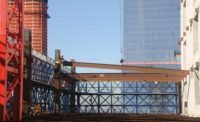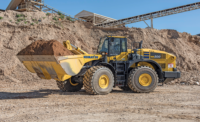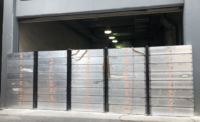When the developer of a tower project on Manhattan's West Side sought to build a platform over 15 active rail tracks leading into the nearby Pennsylvania Station, it had limited options.
The site for the project, Manhattan West, had little laydown space and a steel platform would require columns between tracks. Constructing the columns would interrupt rail service at one of the nation's busiest train stations.
"We were looking at a number of different options when we saw this piece of equipment on a bridge site" in Roslyn, N.Y., recalls Henry Caso, vice president for the developer, Brookfield Properties.
Engineers found that the equipment—a bridge-launching girder, or launching gantry—could be adapted to span the yard's entire 240-ft width. This tactic would avoid having to touch down at the track level or significantly disrupt rail service, which, in turn, would reduce schedule risk by eliminating the need to install foundations between tracks, says Caso.
The gantry was designed and manufactured by the Italian firm Deal. Its sister firm, Rizzani de Eccher, served as construction manager for the platform project. "We said to them, 'Use this precast concrete solution with the gantry—it's safer and there are no touchdowns,' " says Andrea Travani, project manager with Rizzani de Eccher. "We didn't self-perform any of the work. We subbed everything out, but we wanted to pass the knowledge of this sort of system to everyone involved."
Weighing 1,100 tons and standing 100 ft tall at the top of the winch, the 300-ft-wide launching gantry spanned the entire 240-ft gap of the 15-track yard, sliding along on its own track system. With its frame composed of steel-plate box beams, the finished gantry required 20,000 bolts.
Work on assembling the massive machine began in January 2013. By that May it was up and running. "Each of the concrete spans weighed about 2,400 tons, so, with a 1.5 safety factor, we needed a 3,600-ton capacity," says Travani. The gantry was able to travel laterally at about 10 ft per minute and could lower a span at about 6 in. per minute. The hydraulic lifting device used a pin-and-slotted-bar system to raise and lower its load and required only brief interruptions in rail service when each span was finally placed.
The gantry placed the spans within 1/4 in. of precision. "It was all remotely connected to Italy and monitored," Travani says. But, at the site, one operator ran the machine using a remote control.
Each span was made of 37 or 39 precast concrete segments, each weighing about 56 tons, with 32 or 34 post-tensioning tendons in each span. A 240-ft by 50-ft temporary platform provided a staging area to get the first spans in place.
Workers disassembled the gantry in January, after most of the structural work on the platform was done. Construction continues on the surrounding skyscrapers. The platform itself eventually will serve as a sublevel for a public plaza.
"The proof of this method's advantage is that we built this platform on schedule and under budget," says Caso. "Using conventional cranes over a railroad, we would have had much more downtime."
"I would absolutely recommend it to others if they have similar site constraints," he adds. "Working next to Penn Station, we had 15 tracks with a high volume of traffic, and doing it conventionally would have been difficult."
The text of this article was updated to clarify the location of the project.









Post a comment to this article
Report Abusive Comment